Quantitative Literacy 2: Case Study on Californian Nut Industry Theft
VerifiedAdded on 2023/06/12
|10
|2253
|238
Case Study
AI Summary
This case study delves into the Californian nut industry, focusing on the persistent issue of nut theft impacting pistachios, walnuts, and almonds. It begins with an introduction and background, followed by a diagrammatic representation and explanation of the industry's supply chain, highlighting the roles of farmers, commission agents, wholesalers, and retailers. The study identifies vulnerabilities in the supply chain that are exploited by thieves, such as forged documents and digital manipulation of information. It numerically demonstrates the value of the Californian nut industry and the total cost of nut theft, both overall and at specific points in the supply chain. Furthermore, the paper proposes written solutions for preventing nut theft at each point, including stricter truck driver verification, GPS tracking of cargo, and enhanced collaboration between stakeholders. Finally, it estimates the cost savings to the Californian nut industry if these recommendations are adopted, concluding that addressing vulnerabilities in driver identification, technology, and legal enforcement is crucial to mitigating theft and securing the industry's revenue. The document is contributed by a student and available on Desklib, a platform offering study tools for students.
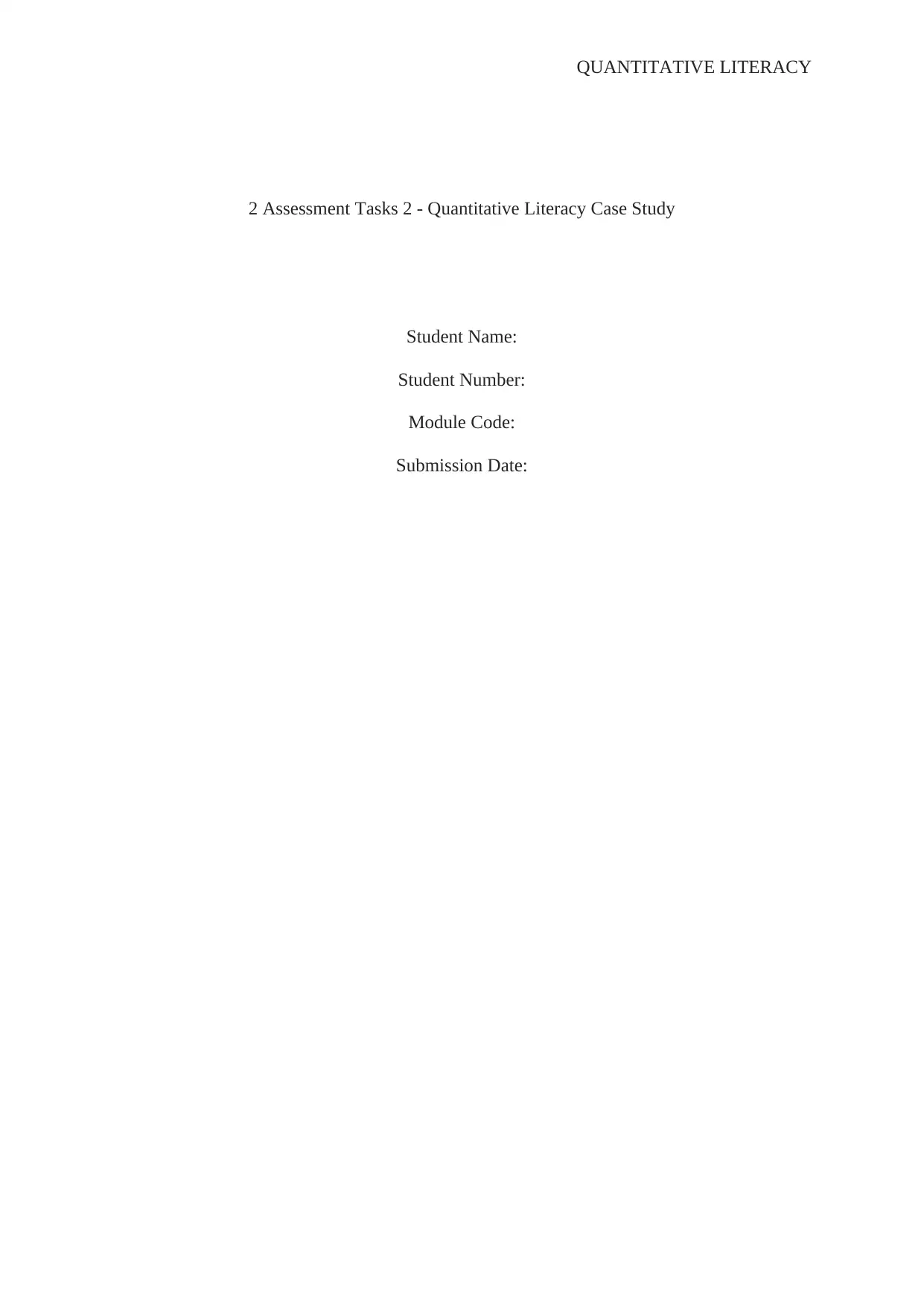
QUANTITATIVE LITERACY
2 Assessment Tasks 2 - Quantitative Literacy Case Study
Student Name:
Student Number:
Module Code:
Submission Date:
2 Assessment Tasks 2 - Quantitative Literacy Case Study
Student Name:
Student Number:
Module Code:
Submission Date:
Paraphrase This Document
Need a fresh take? Get an instant paraphrase of this document with our AI Paraphraser
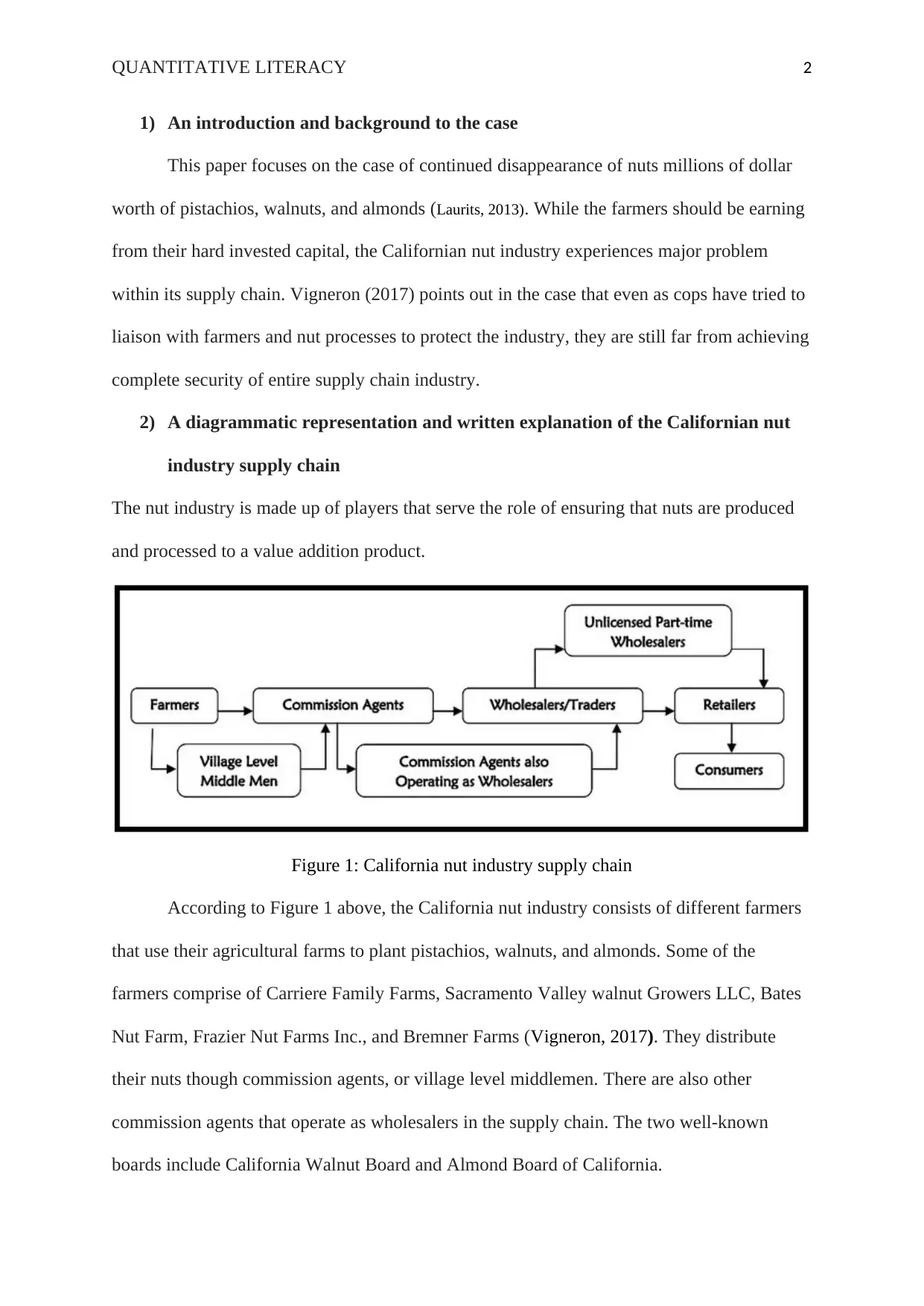
QUANTITATIVE LITERACY 2
1) An introduction and background to the case
This paper focuses on the case of continued disappearance of nuts millions of dollar
worth of pistachios, walnuts, and almonds (Laurits, 2013). While the farmers should be earning
from their hard invested capital, the Californian nut industry experiences major problem
within its supply chain. Vigneron (2017) points out in the case that even as cops have tried to
liaison with farmers and nut processes to protect the industry, they are still far from achieving
complete security of entire supply chain industry.
2) A diagrammatic representation and written explanation of the Californian nut
industry supply chain
The nut industry is made up of players that serve the role of ensuring that nuts are produced
and processed to a value addition product.
Figure 1: California nut industry supply chain
According to Figure 1 above, the California nut industry consists of different farmers
that use their agricultural farms to plant pistachios, walnuts, and almonds. Some of the
farmers comprise of Carriere Family Farms, Sacramento Valley walnut Growers LLC, Bates
Nut Farm, Frazier Nut Farms Inc., and Bremner Farms (Vigneron, 2017). They distribute
their nuts though commission agents, or village level middlemen. There are also other
commission agents that operate as wholesalers in the supply chain. The two well-known
boards include California Walnut Board and Almond Board of California.
1) An introduction and background to the case
This paper focuses on the case of continued disappearance of nuts millions of dollar
worth of pistachios, walnuts, and almonds (Laurits, 2013). While the farmers should be earning
from their hard invested capital, the Californian nut industry experiences major problem
within its supply chain. Vigneron (2017) points out in the case that even as cops have tried to
liaison with farmers and nut processes to protect the industry, they are still far from achieving
complete security of entire supply chain industry.
2) A diagrammatic representation and written explanation of the Californian nut
industry supply chain
The nut industry is made up of players that serve the role of ensuring that nuts are produced
and processed to a value addition product.
Figure 1: California nut industry supply chain
According to Figure 1 above, the California nut industry consists of different farmers
that use their agricultural farms to plant pistachios, walnuts, and almonds. Some of the
farmers comprise of Carriere Family Farms, Sacramento Valley walnut Growers LLC, Bates
Nut Farm, Frazier Nut Farms Inc., and Bremner Farms (Vigneron, 2017). They distribute
their nuts though commission agents, or village level middlemen. There are also other
commission agents that operate as wholesalers in the supply chain. The two well-known
boards include California Walnut Board and Almond Board of California.
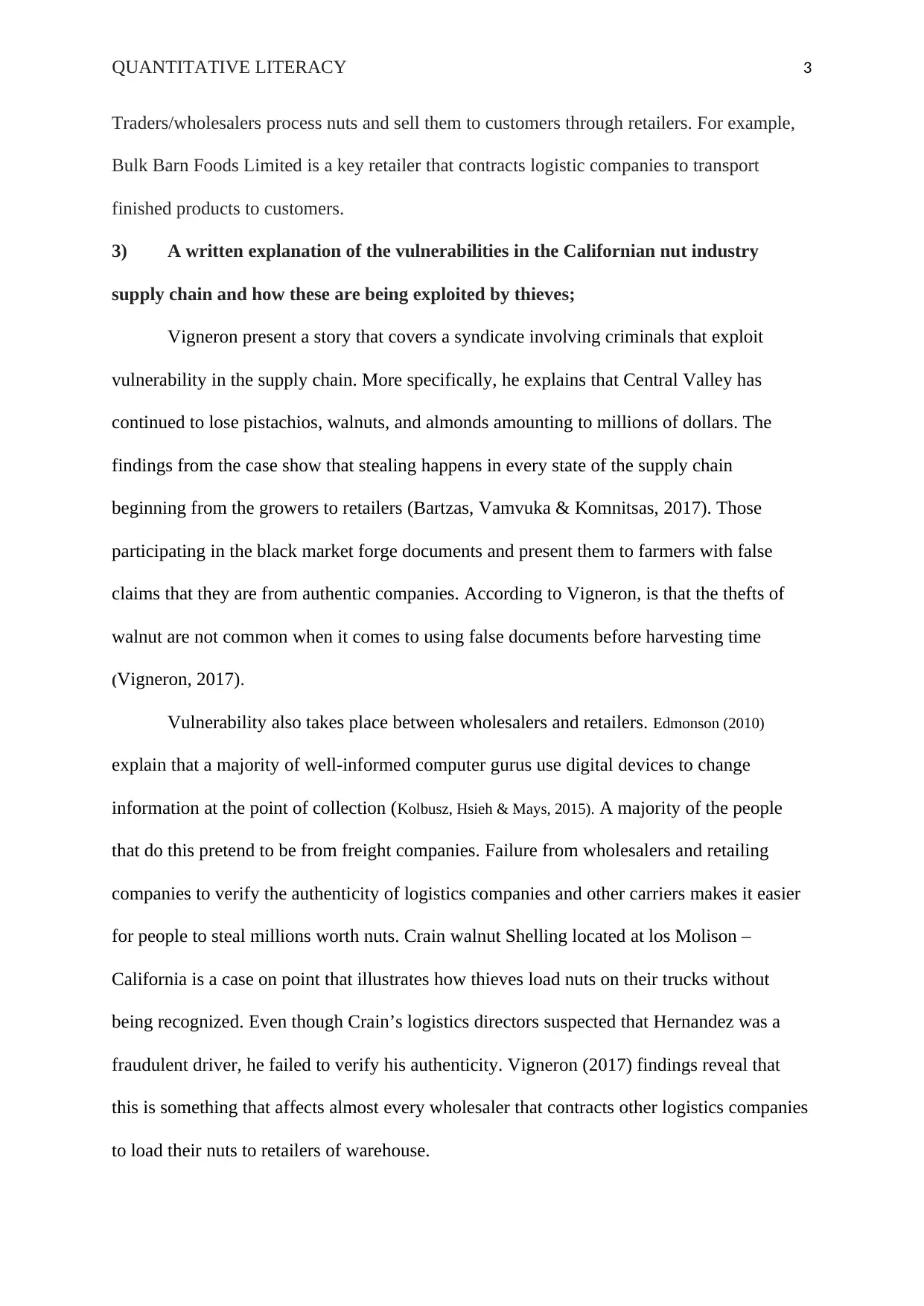
QUANTITATIVE LITERACY 3
Traders/wholesalers process nuts and sell them to customers through retailers. For example,
Bulk Barn Foods Limited is a key retailer that contracts logistic companies to transport
finished products to customers.
3) A written explanation of the vulnerabilities in the Californian nut industry
supply chain and how these are being exploited by thieves;
Vigneron present a story that covers a syndicate involving criminals that exploit
vulnerability in the supply chain. More specifically, he explains that Central Valley has
continued to lose pistachios, walnuts, and almonds amounting to millions of dollars. The
findings from the case show that stealing happens in every state of the supply chain
beginning from the growers to retailers (Bartzas, Vamvuka & Komnitsas, 2017). Those
participating in the black market forge documents and present them to farmers with false
claims that they are from authentic companies. According to Vigneron, is that the thefts of
walnut are not common when it comes to using false documents before harvesting time
(Vigneron, 2017).
Vulnerability also takes place between wholesalers and retailers. Edmonson (2010)
explain that a majority of well-informed computer gurus use digital devices to change
information at the point of collection (Kolbusz, Hsieh & Mays, 2015). A majority of the people
that do this pretend to be from freight companies. Failure from wholesalers and retailing
companies to verify the authenticity of logistics companies and other carriers makes it easier
for people to steal millions worth nuts. Crain walnut Shelling located at los Molison –
California is a case on point that illustrates how thieves load nuts on their trucks without
being recognized. Even though Crain’s logistics directors suspected that Hernandez was a
fraudulent driver, he failed to verify his authenticity. Vigneron (2017) findings reveal that
this is something that affects almost every wholesaler that contracts other logistics companies
to load their nuts to retailers of warehouse.
Traders/wholesalers process nuts and sell them to customers through retailers. For example,
Bulk Barn Foods Limited is a key retailer that contracts logistic companies to transport
finished products to customers.
3) A written explanation of the vulnerabilities in the Californian nut industry
supply chain and how these are being exploited by thieves;
Vigneron present a story that covers a syndicate involving criminals that exploit
vulnerability in the supply chain. More specifically, he explains that Central Valley has
continued to lose pistachios, walnuts, and almonds amounting to millions of dollars. The
findings from the case show that stealing happens in every state of the supply chain
beginning from the growers to retailers (Bartzas, Vamvuka & Komnitsas, 2017). Those
participating in the black market forge documents and present them to farmers with false
claims that they are from authentic companies. According to Vigneron, is that the thefts of
walnut are not common when it comes to using false documents before harvesting time
(Vigneron, 2017).
Vulnerability also takes place between wholesalers and retailers. Edmonson (2010)
explain that a majority of well-informed computer gurus use digital devices to change
information at the point of collection (Kolbusz, Hsieh & Mays, 2015). A majority of the people
that do this pretend to be from freight companies. Failure from wholesalers and retailing
companies to verify the authenticity of logistics companies and other carriers makes it easier
for people to steal millions worth nuts. Crain walnut Shelling located at los Molison –
California is a case on point that illustrates how thieves load nuts on their trucks without
being recognized. Even though Crain’s logistics directors suspected that Hernandez was a
fraudulent driver, he failed to verify his authenticity. Vigneron (2017) findings reveal that
this is something that affects almost every wholesaler that contracts other logistics companies
to load their nuts to retailers of warehouse.
⊘ This is a preview!⊘
Do you want full access?
Subscribe today to unlock all pages.

Trusted by 1+ million students worldwide
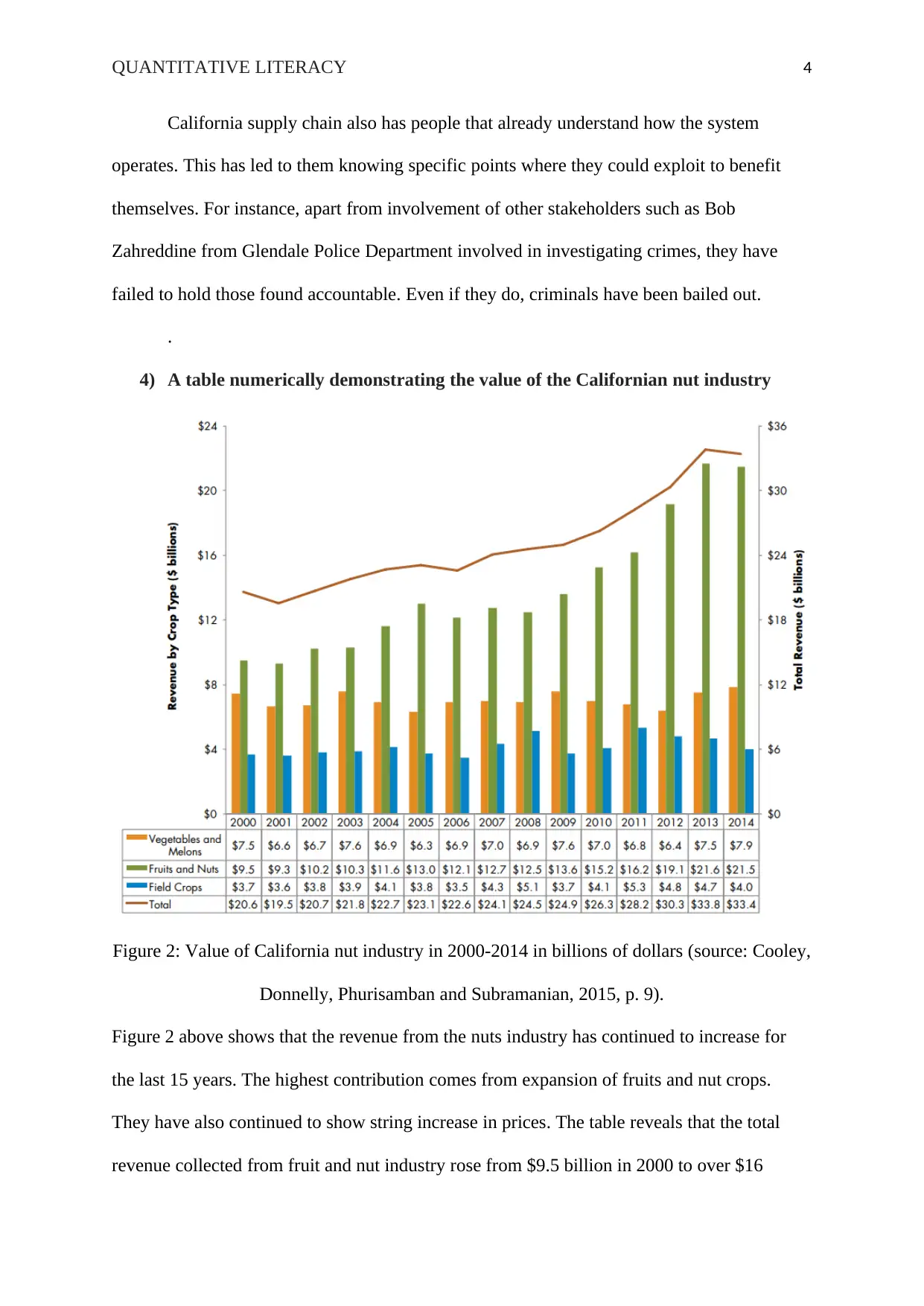
QUANTITATIVE LITERACY 4
California supply chain also has people that already understand how the system
operates. This has led to them knowing specific points where they could exploit to benefit
themselves. For instance, apart from involvement of other stakeholders such as Bob
Zahreddine from Glendale Police Department involved in investigating crimes, they have
failed to hold those found accountable. Even if they do, criminals have been bailed out.
.
4) A table numerically demonstrating the value of the Californian nut industry
Figure 2: Value of California nut industry in 2000-2014 in billions of dollars (source: Cooley,
Donnelly, Phurisamban and Subramanian, 2015, p. 9).
Figure 2 above shows that the revenue from the nuts industry has continued to increase for
the last 15 years. The highest contribution comes from expansion of fruits and nut crops.
They have also continued to show string increase in prices. The table reveals that the total
revenue collected from fruit and nut industry rose from $9.5 billion in 2000 to over $16
California supply chain also has people that already understand how the system
operates. This has led to them knowing specific points where they could exploit to benefit
themselves. For instance, apart from involvement of other stakeholders such as Bob
Zahreddine from Glendale Police Department involved in investigating crimes, they have
failed to hold those found accountable. Even if they do, criminals have been bailed out.
.
4) A table numerically demonstrating the value of the Californian nut industry
Figure 2: Value of California nut industry in 2000-2014 in billions of dollars (source: Cooley,
Donnelly, Phurisamban and Subramanian, 2015, p. 9).
Figure 2 above shows that the revenue from the nuts industry has continued to increase for
the last 15 years. The highest contribution comes from expansion of fruits and nut crops.
They have also continued to show string increase in prices. The table reveals that the total
revenue collected from fruit and nut industry rose from $9.5 billion in 2000 to over $16
Paraphrase This Document
Need a fresh take? Get an instant paraphrase of this document with our AI Paraphraser
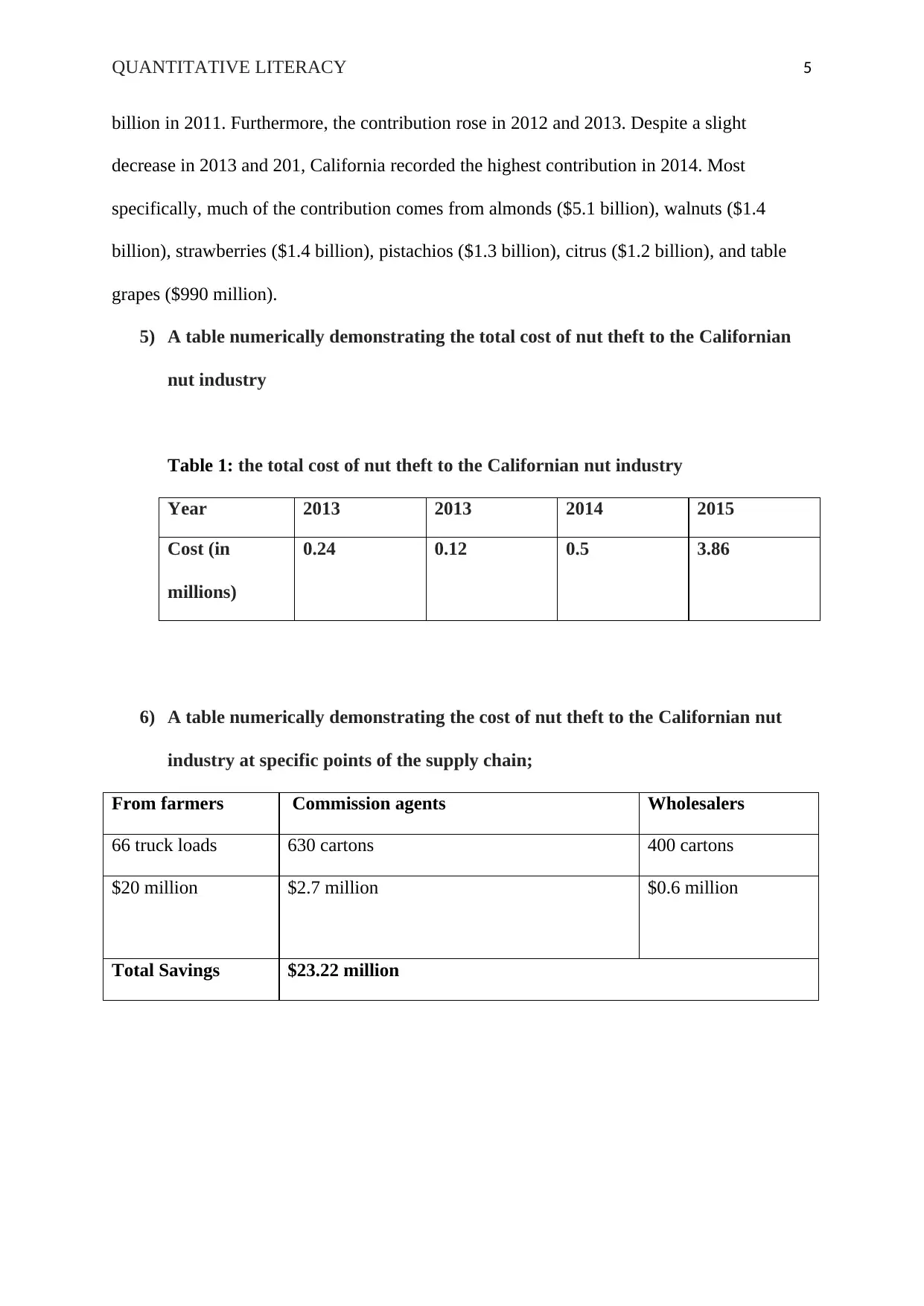
QUANTITATIVE LITERACY 5
billion in 2011. Furthermore, the contribution rose in 2012 and 2013. Despite a slight
decrease in 2013 and 201, California recorded the highest contribution in 2014. Most
specifically, much of the contribution comes from almonds ($5.1 billion), walnuts ($1.4
billion), strawberries ($1.4 billion), pistachios ($1.3 billion), citrus ($1.2 billion), and table
grapes ($990 million).
5) A table numerically demonstrating the total cost of nut theft to the Californian
nut industry
Table 1: the total cost of nut theft to the Californian nut industry
Year 2013 2013 2014 2015
Cost (in
millions)
0.24 0.12 0.5 3.86
6) A table numerically demonstrating the cost of nut theft to the Californian nut
industry at specific points of the supply chain;
From farmers Commission agents Wholesalers
66 truck loads 630 cartons 400 cartons
$20 million $2.7 million $0.6 million
Total Savings $23.22 million
billion in 2011. Furthermore, the contribution rose in 2012 and 2013. Despite a slight
decrease in 2013 and 201, California recorded the highest contribution in 2014. Most
specifically, much of the contribution comes from almonds ($5.1 billion), walnuts ($1.4
billion), strawberries ($1.4 billion), pistachios ($1.3 billion), citrus ($1.2 billion), and table
grapes ($990 million).
5) A table numerically demonstrating the total cost of nut theft to the Californian
nut industry
Table 1: the total cost of nut theft to the Californian nut industry
Year 2013 2013 2014 2015
Cost (in
millions)
0.24 0.12 0.5 3.86
6) A table numerically demonstrating the cost of nut theft to the Californian nut
industry at specific points of the supply chain;
From farmers Commission agents Wholesalers
66 truck loads 630 cartons 400 cartons
$20 million $2.7 million $0.6 million
Total Savings $23.22 million
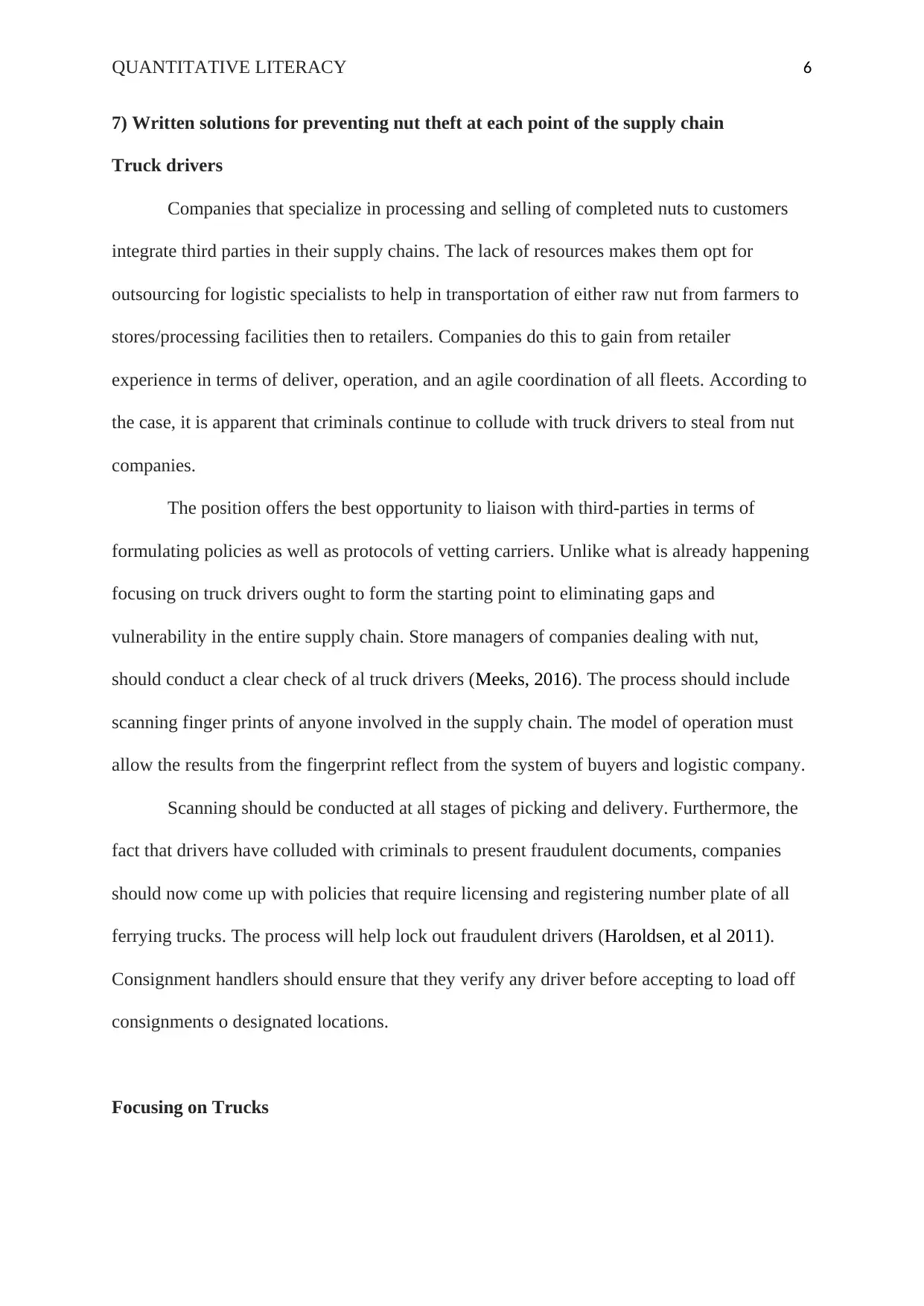
QUANTITATIVE LITERACY 6
7) Written solutions for preventing nut theft at each point of the supply chain
Truck drivers
Companies that specialize in processing and selling of completed nuts to customers
integrate third parties in their supply chains. The lack of resources makes them opt for
outsourcing for logistic specialists to help in transportation of either raw nut from farmers to
stores/processing facilities then to retailers. Companies do this to gain from retailer
experience in terms of deliver, operation, and an agile coordination of all fleets. According to
the case, it is apparent that criminals continue to collude with truck drivers to steal from nut
companies.
The position offers the best opportunity to liaison with third-parties in terms of
formulating policies as well as protocols of vetting carriers. Unlike what is already happening
focusing on truck drivers ought to form the starting point to eliminating gaps and
vulnerability in the entire supply chain. Store managers of companies dealing with nut,
should conduct a clear check of al truck drivers (Meeks, 2016). The process should include
scanning finger prints of anyone involved in the supply chain. The model of operation must
allow the results from the fingerprint reflect from the system of buyers and logistic company.
Scanning should be conducted at all stages of picking and delivery. Furthermore, the
fact that drivers have colluded with criminals to present fraudulent documents, companies
should now come up with policies that require licensing and registering number plate of all
ferrying trucks. The process will help lock out fraudulent drivers (Haroldsen, et al 2011).
Consignment handlers should ensure that they verify any driver before accepting to load off
consignments o designated locations.
Focusing on Trucks
7) Written solutions for preventing nut theft at each point of the supply chain
Truck drivers
Companies that specialize in processing and selling of completed nuts to customers
integrate third parties in their supply chains. The lack of resources makes them opt for
outsourcing for logistic specialists to help in transportation of either raw nut from farmers to
stores/processing facilities then to retailers. Companies do this to gain from retailer
experience in terms of deliver, operation, and an agile coordination of all fleets. According to
the case, it is apparent that criminals continue to collude with truck drivers to steal from nut
companies.
The position offers the best opportunity to liaison with third-parties in terms of
formulating policies as well as protocols of vetting carriers. Unlike what is already happening
focusing on truck drivers ought to form the starting point to eliminating gaps and
vulnerability in the entire supply chain. Store managers of companies dealing with nut,
should conduct a clear check of al truck drivers (Meeks, 2016). The process should include
scanning finger prints of anyone involved in the supply chain. The model of operation must
allow the results from the fingerprint reflect from the system of buyers and logistic company.
Scanning should be conducted at all stages of picking and delivery. Furthermore, the
fact that drivers have colluded with criminals to present fraudulent documents, companies
should now come up with policies that require licensing and registering number plate of all
ferrying trucks. The process will help lock out fraudulent drivers (Haroldsen, et al 2011).
Consignment handlers should ensure that they verify any driver before accepting to load off
consignments o designated locations.
Focusing on Trucks
⊘ This is a preview!⊘
Do you want full access?
Subscribe today to unlock all pages.

Trusted by 1+ million students worldwide
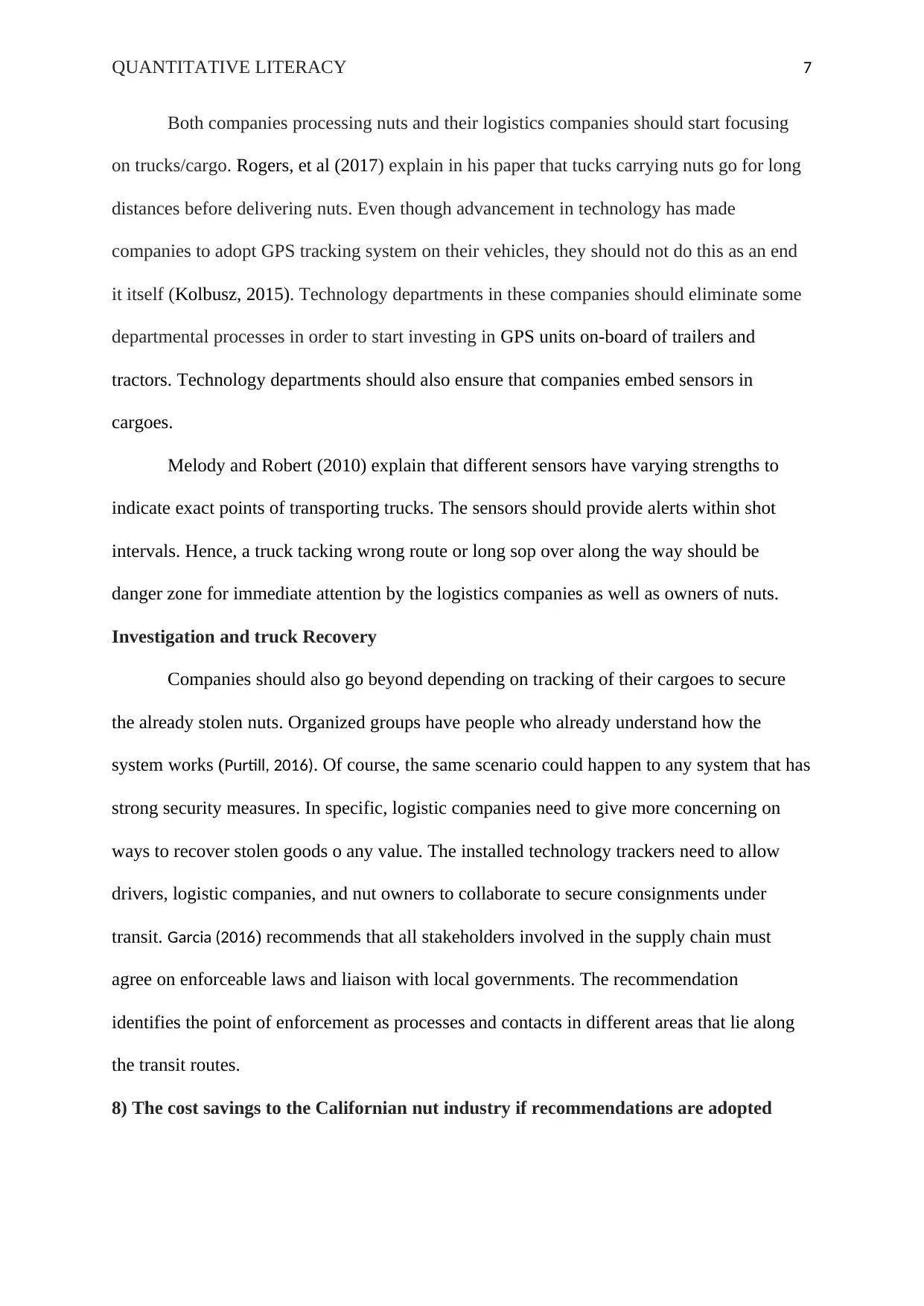
QUANTITATIVE LITERACY 7
Both companies processing nuts and their logistics companies should start focusing
on trucks/cargo. Rogers, et al (2017) explain in his paper that tucks carrying nuts go for long
distances before delivering nuts. Even though advancement in technology has made
companies to adopt GPS tracking system on their vehicles, they should not do this as an end
it itself (Kolbusz, 2015). Technology departments in these companies should eliminate some
departmental processes in order to start investing in GPS units on-board of trailers and
tractors. Technology departments should also ensure that companies embed sensors in
cargoes.
Melody and Robert (2010) explain that different sensors have varying strengths to
indicate exact points of transporting trucks. The sensors should provide alerts within shot
intervals. Hence, a truck tacking wrong route or long sop over along the way should be
danger zone for immediate attention by the logistics companies as well as owners of nuts.
Investigation and truck Recovery
Companies should also go beyond depending on tracking of their cargoes to secure
the already stolen nuts. Organized groups have people who already understand how the
system works (Purtill, 2016). Of course, the same scenario could happen to any system that has
strong security measures. In specific, logistic companies need to give more concerning on
ways to recover stolen goods o any value. The installed technology trackers need to allow
drivers, logistic companies, and nut owners to collaborate to secure consignments under
transit. Garcia (2016) recommends that all stakeholders involved in the supply chain must
agree on enforceable laws and liaison with local governments. The recommendation
identifies the point of enforcement as processes and contacts in different areas that lie along
the transit routes.
8) The cost savings to the Californian nut industry if recommendations are adopted
Both companies processing nuts and their logistics companies should start focusing
on trucks/cargo. Rogers, et al (2017) explain in his paper that tucks carrying nuts go for long
distances before delivering nuts. Even though advancement in technology has made
companies to adopt GPS tracking system on their vehicles, they should not do this as an end
it itself (Kolbusz, 2015). Technology departments in these companies should eliminate some
departmental processes in order to start investing in GPS units on-board of trailers and
tractors. Technology departments should also ensure that companies embed sensors in
cargoes.
Melody and Robert (2010) explain that different sensors have varying strengths to
indicate exact points of transporting trucks. The sensors should provide alerts within shot
intervals. Hence, a truck tacking wrong route or long sop over along the way should be
danger zone for immediate attention by the logistics companies as well as owners of nuts.
Investigation and truck Recovery
Companies should also go beyond depending on tracking of their cargoes to secure
the already stolen nuts. Organized groups have people who already understand how the
system works (Purtill, 2016). Of course, the same scenario could happen to any system that has
strong security measures. In specific, logistic companies need to give more concerning on
ways to recover stolen goods o any value. The installed technology trackers need to allow
drivers, logistic companies, and nut owners to collaborate to secure consignments under
transit. Garcia (2016) recommends that all stakeholders involved in the supply chain must
agree on enforceable laws and liaison with local governments. The recommendation
identifies the point of enforcement as processes and contacts in different areas that lie along
the transit routes.
8) The cost savings to the Californian nut industry if recommendations are adopted
Paraphrase This Document
Need a fresh take? Get an instant paraphrase of this document with our AI Paraphraser
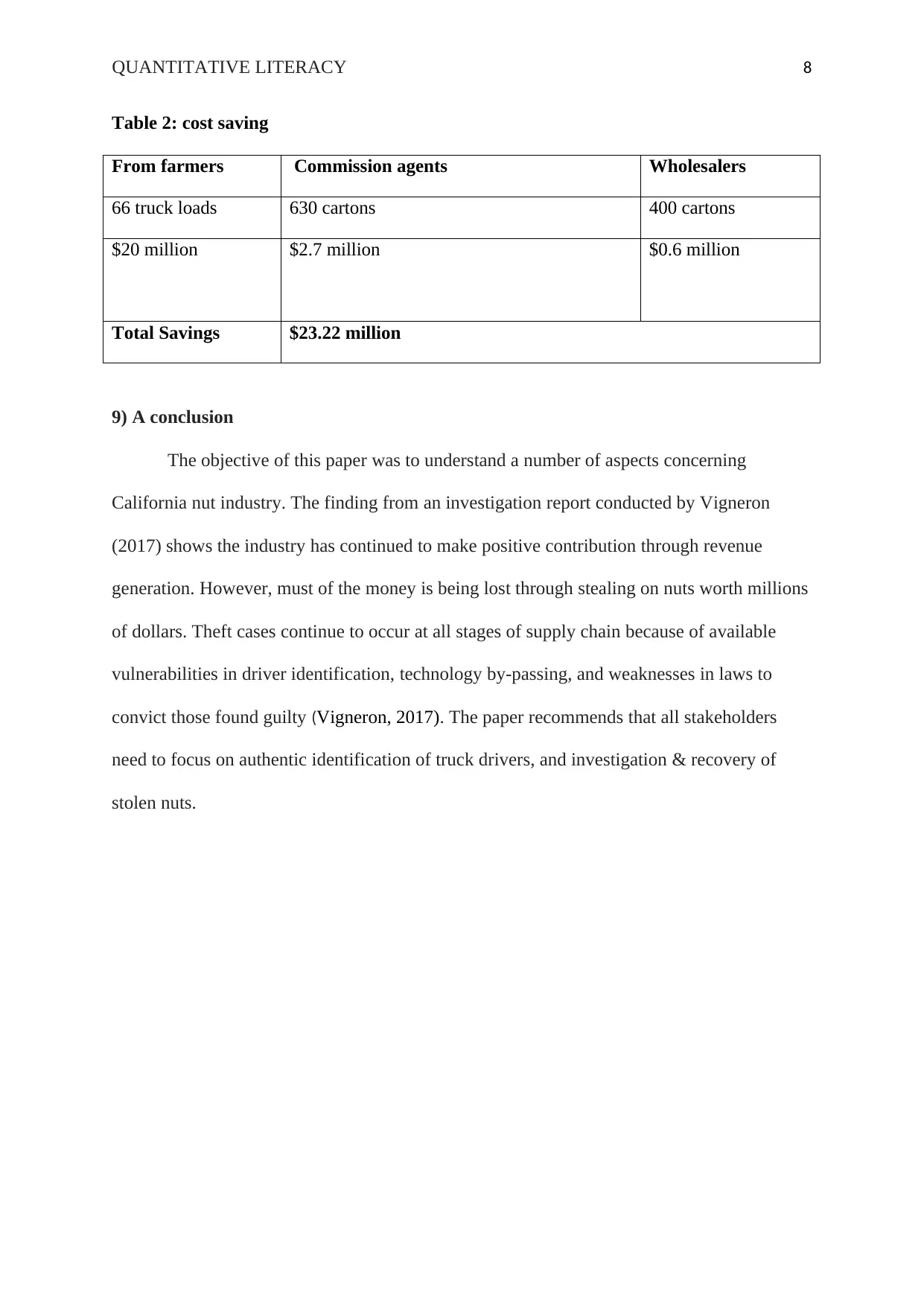
QUANTITATIVE LITERACY 8
Table 2: cost saving
From farmers Commission agents Wholesalers
66 truck loads 630 cartons 400 cartons
$20 million $2.7 million $0.6 million
Total Savings $23.22 million
9) A conclusion
The objective of this paper was to understand a number of aspects concerning
California nut industry. The finding from an investigation report conducted by Vigneron
(2017) shows the industry has continued to make positive contribution through revenue
generation. However, must of the money is being lost through stealing on nuts worth millions
of dollars. Theft cases continue to occur at all stages of supply chain because of available
vulnerabilities in driver identification, technology by-passing, and weaknesses in laws to
convict those found guilty (Vigneron, 2017). The paper recommends that all stakeholders
need to focus on authentic identification of truck drivers, and investigation & recovery of
stolen nuts.
Table 2: cost saving
From farmers Commission agents Wholesalers
66 truck loads 630 cartons 400 cartons
$20 million $2.7 million $0.6 million
Total Savings $23.22 million
9) A conclusion
The objective of this paper was to understand a number of aspects concerning
California nut industry. The finding from an investigation report conducted by Vigneron
(2017) shows the industry has continued to make positive contribution through revenue
generation. However, must of the money is being lost through stealing on nuts worth millions
of dollars. Theft cases continue to occur at all stages of supply chain because of available
vulnerabilities in driver identification, technology by-passing, and weaknesses in laws to
convict those found guilty (Vigneron, 2017). The paper recommends that all stakeholders
need to focus on authentic identification of truck drivers, and investigation & recovery of
stolen nuts.
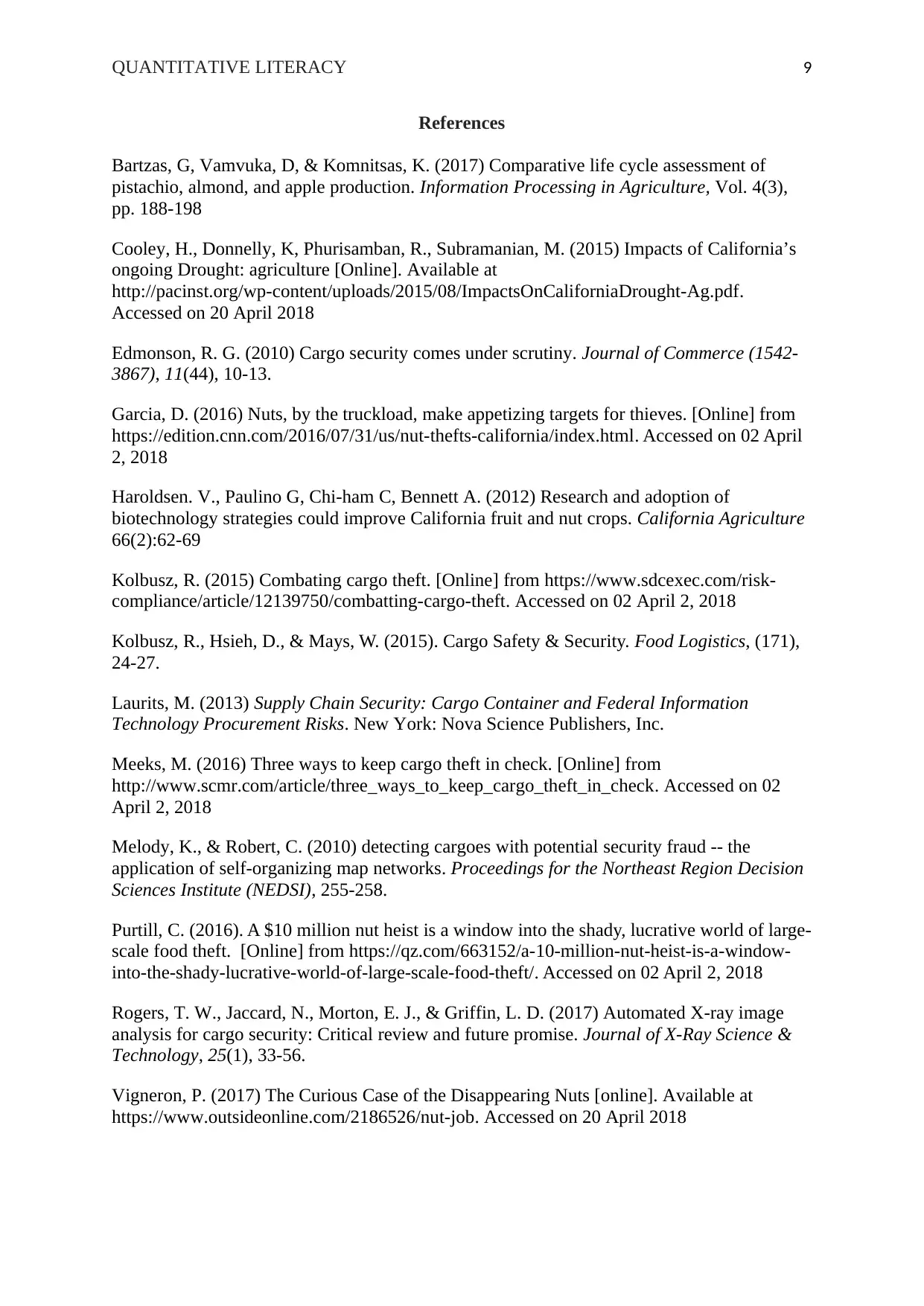
QUANTITATIVE LITERACY 9
References
Bartzas, G, Vamvuka, D, & Komnitsas, K. (2017) Comparative life cycle assessment of
pistachio, almond, and apple production. Information Processing in Agriculture, Vol. 4(3),
pp. 188-198
Cooley, H., Donnelly, K, Phurisamban, R., Subramanian, M. (2015) Impacts of California’s
ongoing Drought: agriculture [Online]. Available at
http://pacinst.org/wp-content/uploads/2015/08/ImpactsOnCaliforniaDrought-Ag.pdf.
Accessed on 20 April 2018
Edmonson, R. G. (2010) Cargo security comes under scrutiny. Journal of Commerce (1542-
3867), 11(44), 10-13.
Garcia, D. (2016) Nuts, by the truckload, make appetizing targets for thieves. [Online] from
https://edition.cnn.com/2016/07/31/us/nut-thefts-california/index.html. Accessed on 02 April
2, 2018
Haroldsen. V., Paulino G, Chi-ham C, Bennett A. (2012) Research and adoption of
biotechnology strategies could improve California fruit and nut crops. California Agriculture
66(2):62-69
Kolbusz, R. (2015) Combating cargo theft. [Online] from https://www.sdcexec.com/risk-
compliance/article/12139750/combatting-cargo-theft. Accessed on 02 April 2, 2018
Kolbusz, R., Hsieh, D., & Mays, W. (2015). Cargo Safety & Security. Food Logistics, (171),
24-27.
Laurits, M. (2013) Supply Chain Security: Cargo Container and Federal Information
Technology Procurement Risks. New York: Nova Science Publishers, Inc.
Meeks, M. (2016) Three ways to keep cargo theft in check. [Online] from
http://www.scmr.com/article/three_ways_to_keep_cargo_theft_in_check. Accessed on 02
April 2, 2018
Melody, K., & Robert, C. (2010) detecting cargoes with potential security fraud -- the
application of self-organizing map networks. Proceedings for the Northeast Region Decision
Sciences Institute (NEDSI), 255-258.
Purtill, C. (2016). A $10 million nut heist is a window into the shady, lucrative world of large-
scale food theft. [Online] from https://qz.com/663152/a-10-million-nut-heist-is-a-window-
into-the-shady-lucrative-world-of-large-scale-food-theft/. Accessed on 02 April 2, 2018
Rogers, T. W., Jaccard, N., Morton, E. J., & Griffin, L. D. (2017) Automated X-ray image
analysis for cargo security: Critical review and future promise. Journal of X-Ray Science &
Technology, 25(1), 33-56.
Vigneron, P. (2017) The Curious Case of the Disappearing Nuts [online]. Available at
https://www.outsideonline.com/2186526/nut-job. Accessed on 20 April 2018
References
Bartzas, G, Vamvuka, D, & Komnitsas, K. (2017) Comparative life cycle assessment of
pistachio, almond, and apple production. Information Processing in Agriculture, Vol. 4(3),
pp. 188-198
Cooley, H., Donnelly, K, Phurisamban, R., Subramanian, M. (2015) Impacts of California’s
ongoing Drought: agriculture [Online]. Available at
http://pacinst.org/wp-content/uploads/2015/08/ImpactsOnCaliforniaDrought-Ag.pdf.
Accessed on 20 April 2018
Edmonson, R. G. (2010) Cargo security comes under scrutiny. Journal of Commerce (1542-
3867), 11(44), 10-13.
Garcia, D. (2016) Nuts, by the truckload, make appetizing targets for thieves. [Online] from
https://edition.cnn.com/2016/07/31/us/nut-thefts-california/index.html. Accessed on 02 April
2, 2018
Haroldsen. V., Paulino G, Chi-ham C, Bennett A. (2012) Research and adoption of
biotechnology strategies could improve California fruit and nut crops. California Agriculture
66(2):62-69
Kolbusz, R. (2015) Combating cargo theft. [Online] from https://www.sdcexec.com/risk-
compliance/article/12139750/combatting-cargo-theft. Accessed on 02 April 2, 2018
Kolbusz, R., Hsieh, D., & Mays, W. (2015). Cargo Safety & Security. Food Logistics, (171),
24-27.
Laurits, M. (2013) Supply Chain Security: Cargo Container and Federal Information
Technology Procurement Risks. New York: Nova Science Publishers, Inc.
Meeks, M. (2016) Three ways to keep cargo theft in check. [Online] from
http://www.scmr.com/article/three_ways_to_keep_cargo_theft_in_check. Accessed on 02
April 2, 2018
Melody, K., & Robert, C. (2010) detecting cargoes with potential security fraud -- the
application of self-organizing map networks. Proceedings for the Northeast Region Decision
Sciences Institute (NEDSI), 255-258.
Purtill, C. (2016). A $10 million nut heist is a window into the shady, lucrative world of large-
scale food theft. [Online] from https://qz.com/663152/a-10-million-nut-heist-is-a-window-
into-the-shady-lucrative-world-of-large-scale-food-theft/. Accessed on 02 April 2, 2018
Rogers, T. W., Jaccard, N., Morton, E. J., & Griffin, L. D. (2017) Automated X-ray image
analysis for cargo security: Critical review and future promise. Journal of X-Ray Science &
Technology, 25(1), 33-56.
Vigneron, P. (2017) The Curious Case of the Disappearing Nuts [online]. Available at
https://www.outsideonline.com/2186526/nut-job. Accessed on 20 April 2018
⊘ This is a preview!⊘
Do you want full access?
Subscribe today to unlock all pages.

Trusted by 1+ million students worldwide

QUANTITATIVE LITERACY 10
1 out of 10
Related Documents
Your All-in-One AI-Powered Toolkit for Academic Success.
+13062052269
info@desklib.com
Available 24*7 on WhatsApp / Email
![[object Object]](/_next/static/media/star-bottom.7253800d.svg)
Unlock your academic potential
Copyright © 2020–2025 A2Z Services. All Rights Reserved. Developed and managed by ZUCOL.





